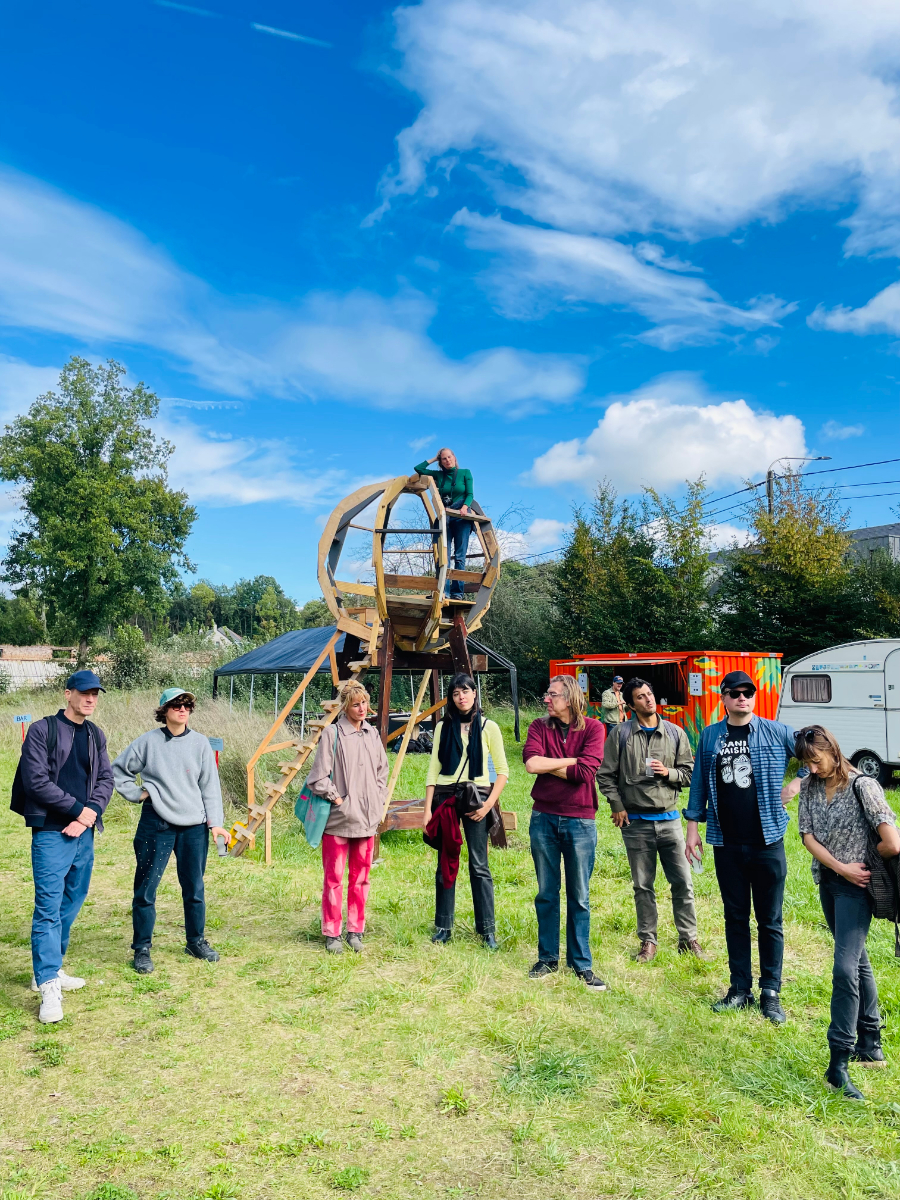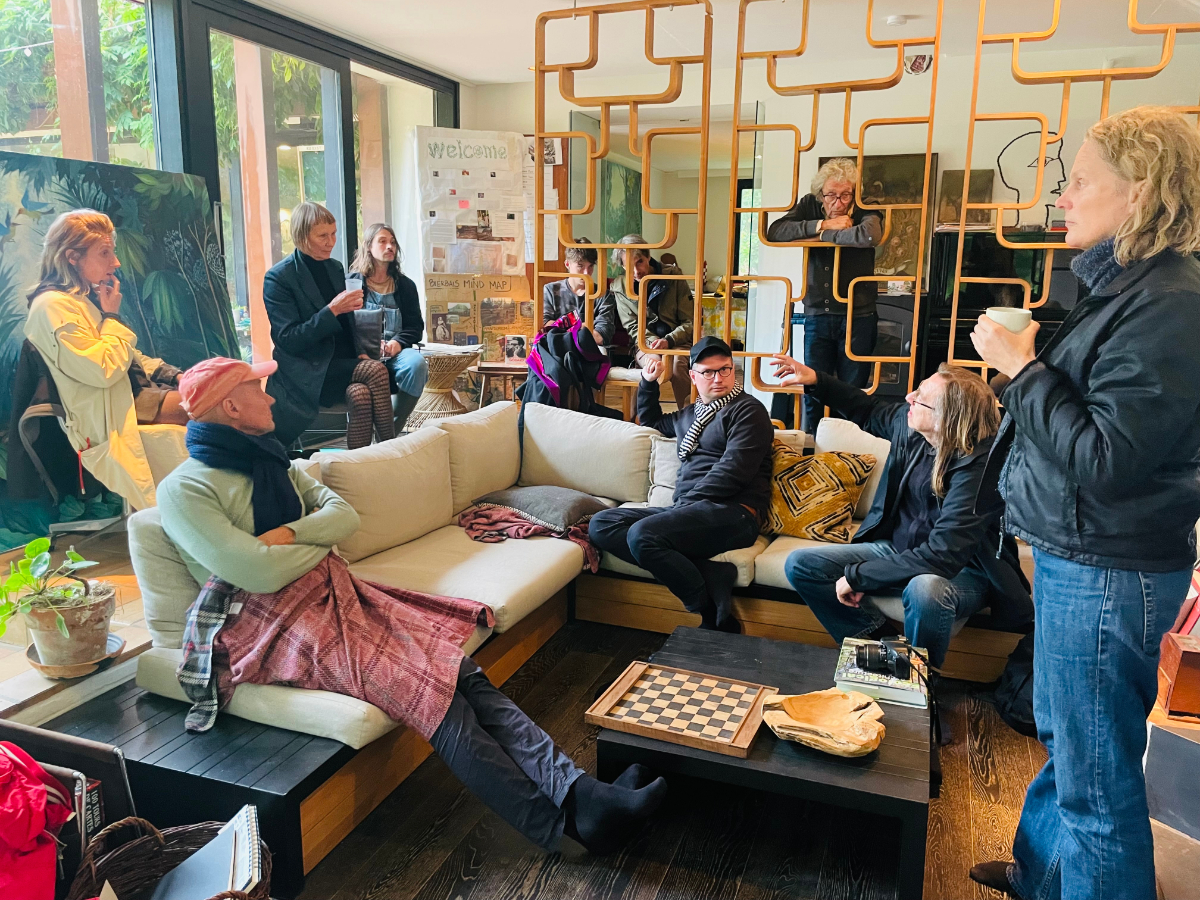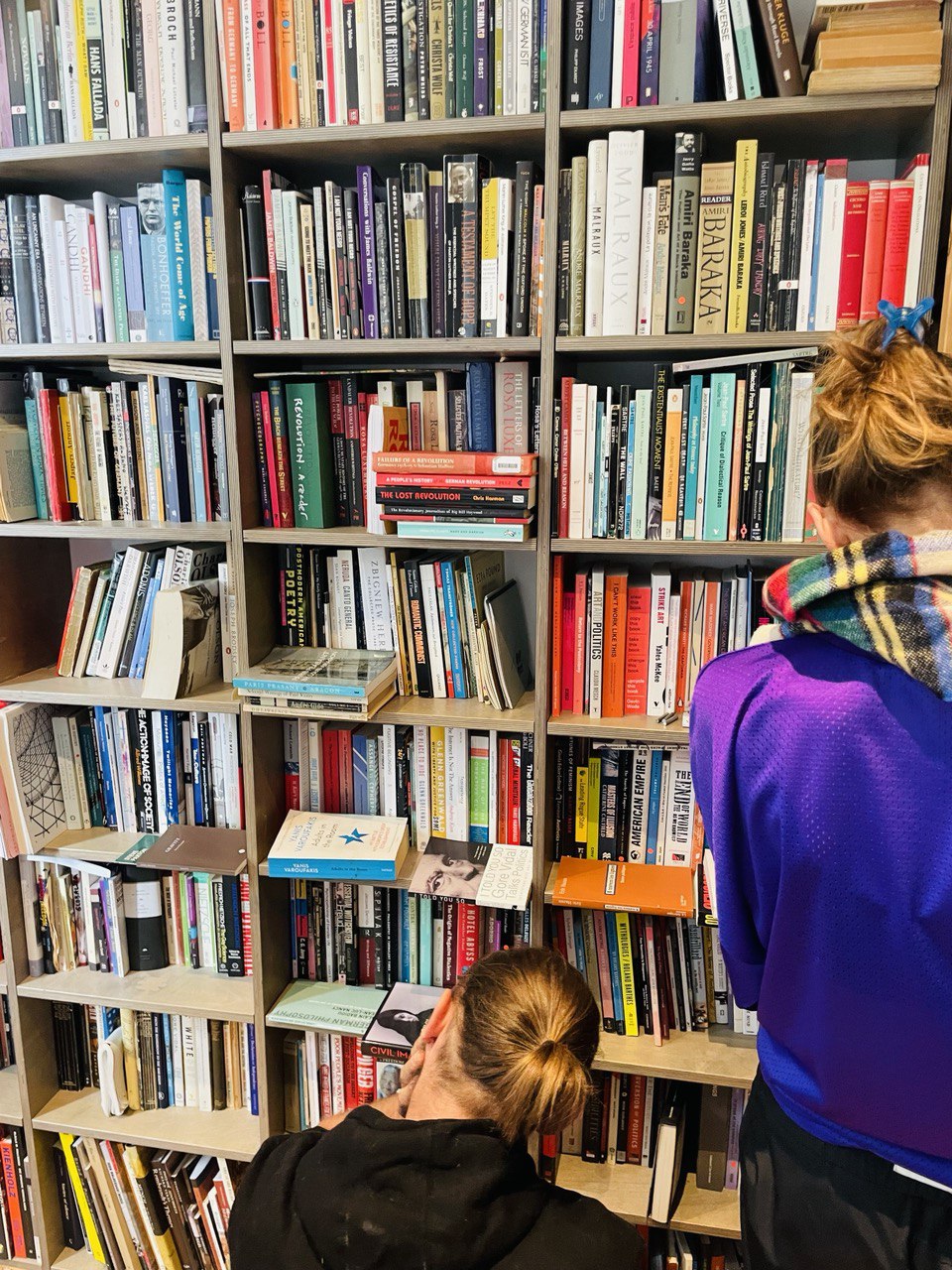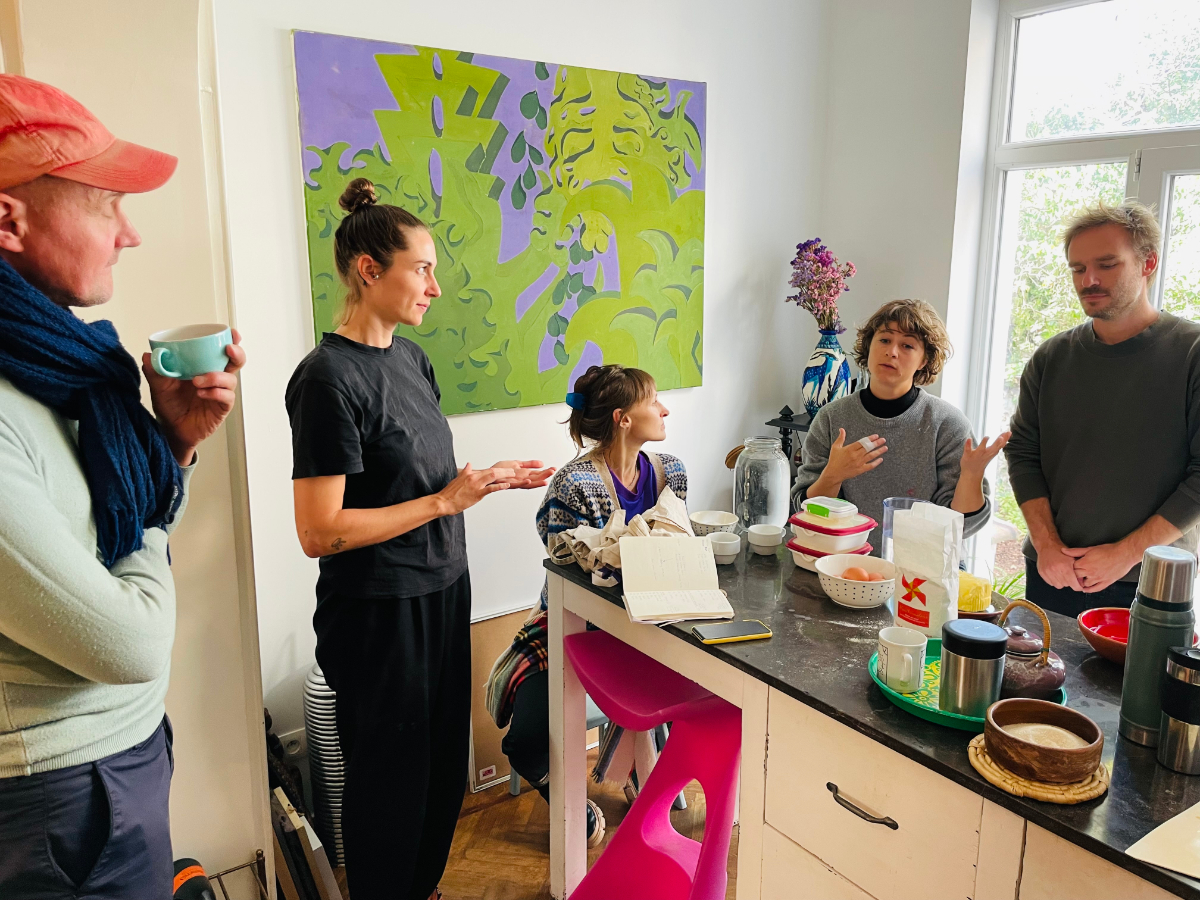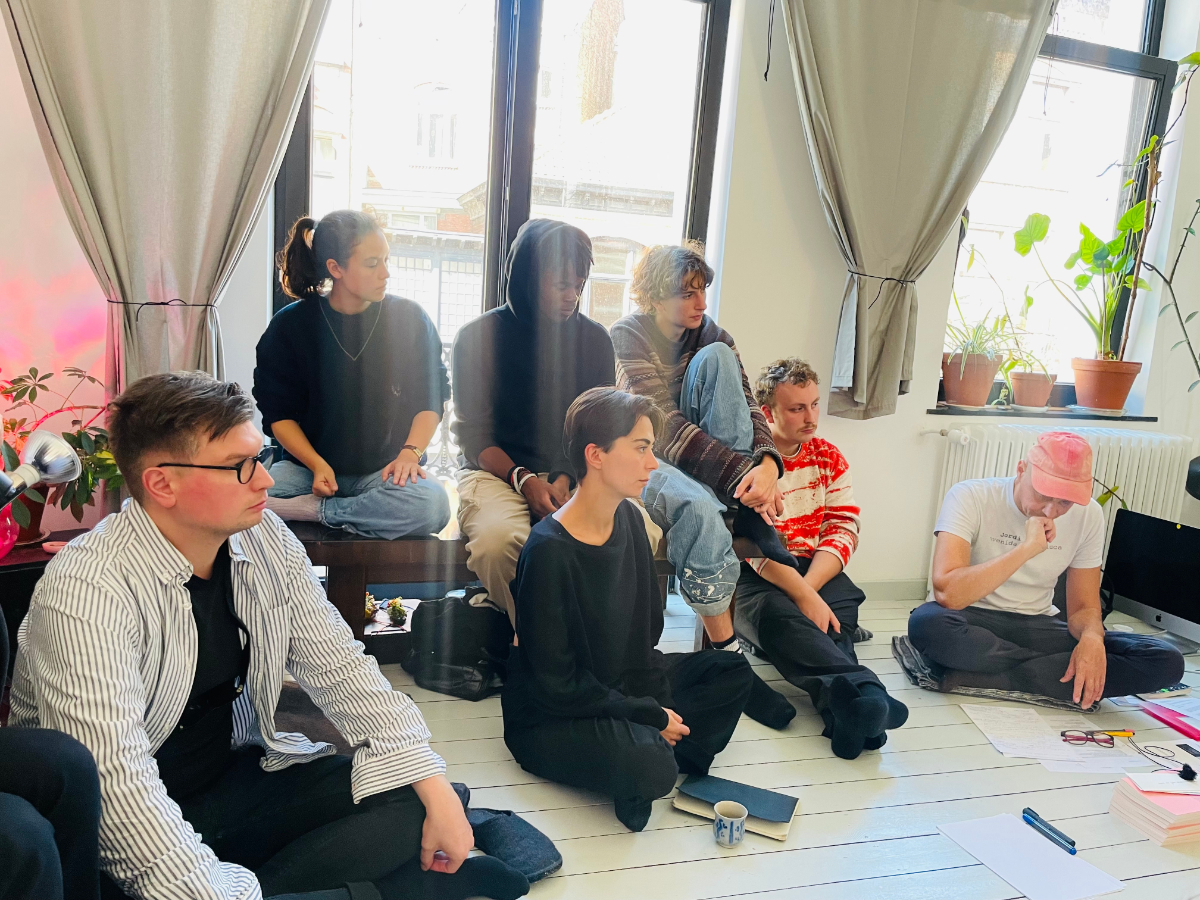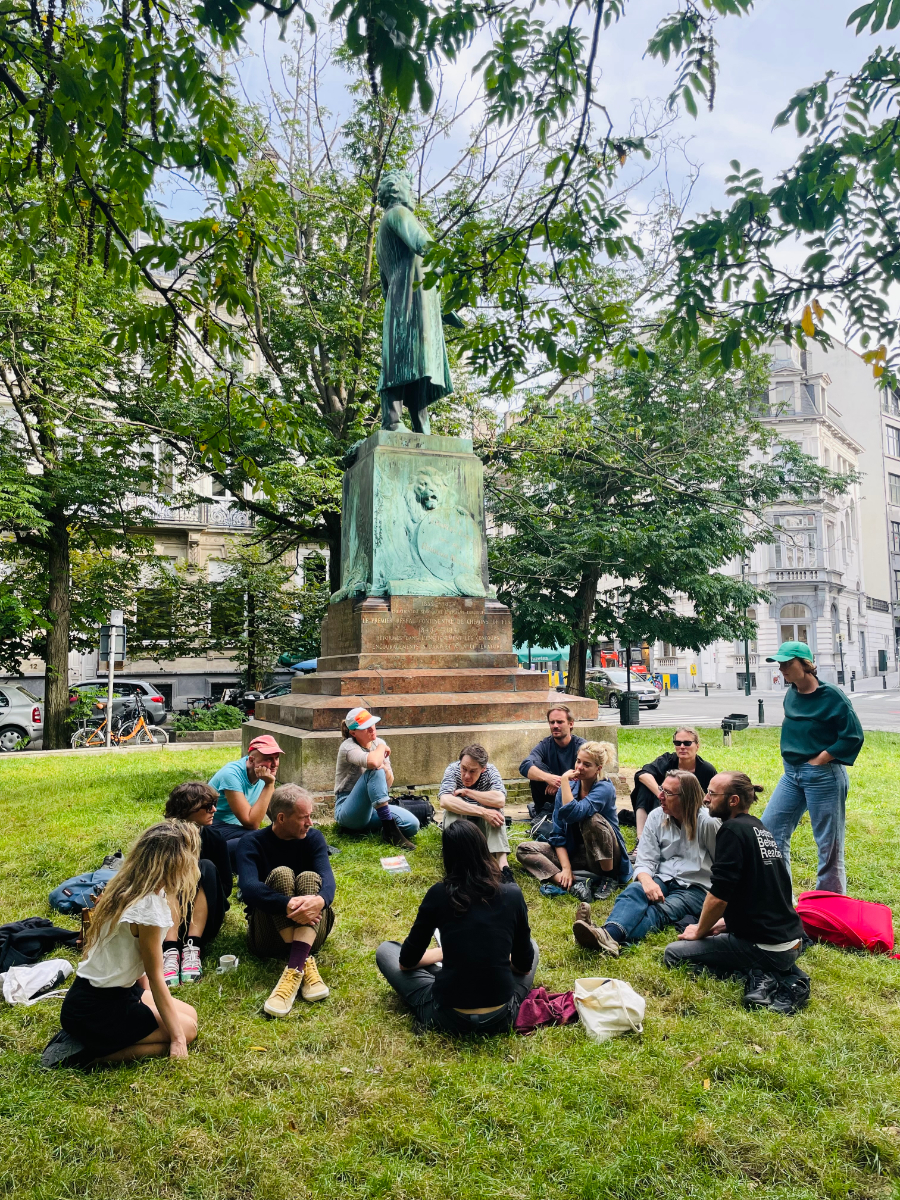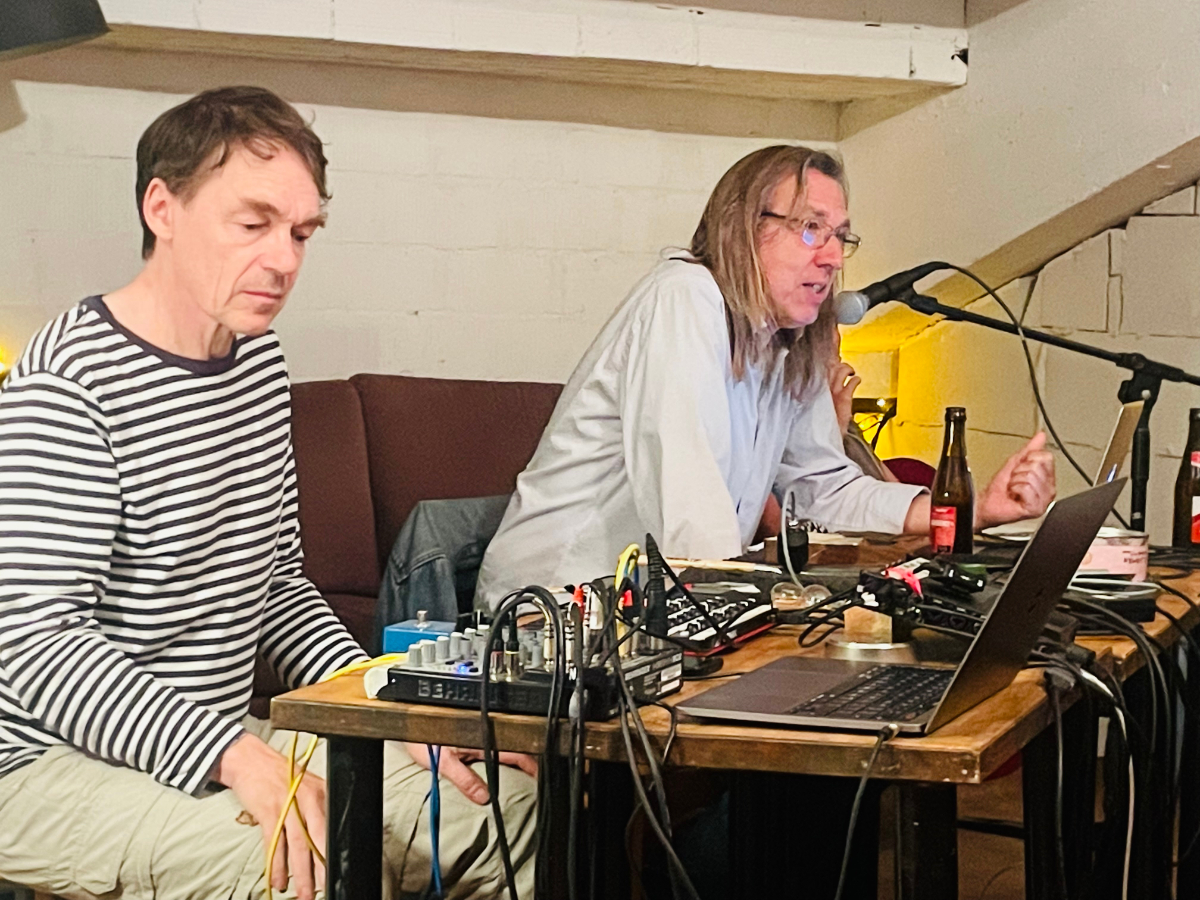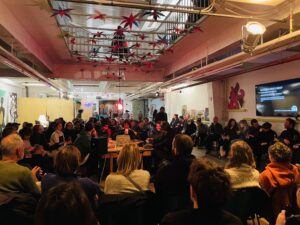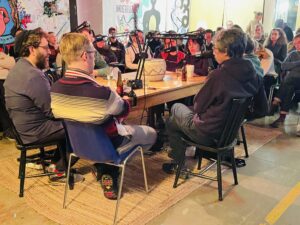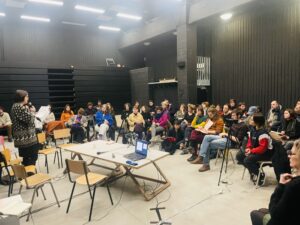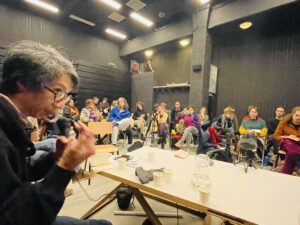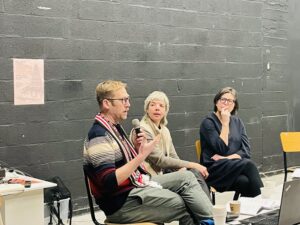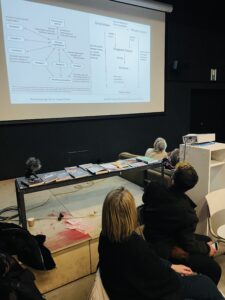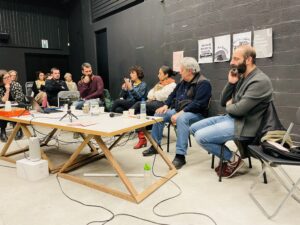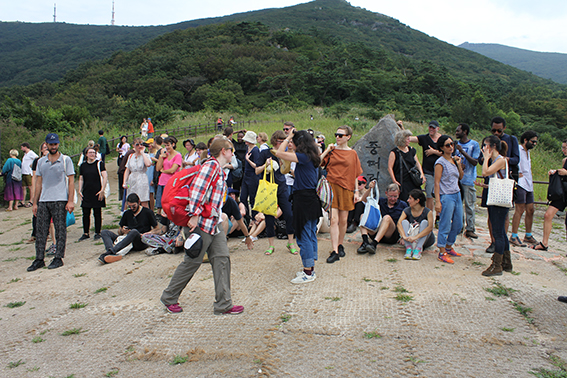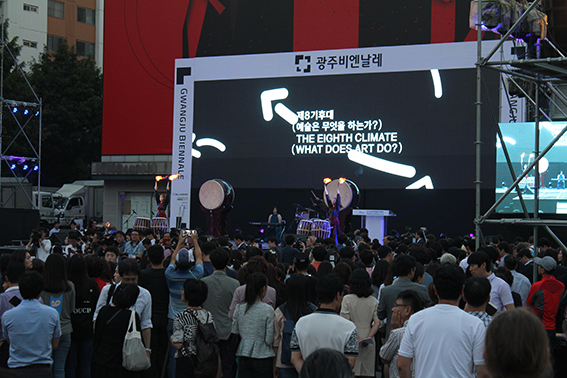Jubilee Summer School Brussels: Alternative Learning and Self-organisation
22 – 26/09/2023
Various locations in and around Brussels
This summer school brings together a group of artists and researchers associated with Jubilee. The platform has been imagining and inventing an artist-run platform for artistic research since 2012. For this summer school everyone involved presents work, research or processes connected to alternative learning, presents their collective or organisation and its ways of working from which we can learn, or proposes activities framed by ideas of alternative learning, local knowledge, and self-organisation. Jubilee is itself a tool for artistic researchers to develop, produce and present their work. As such, it has developed different tools for artistic research for which this summer school has particular attention.
For the detailed programme, please see further below. Two moments are fully public:
Monday 25/09, 19:30h
Project(ion) Room – De Praeterestraat 55, 1180 Ukkel
Le balai libéré
Coline Grando, 2023, 88 min.
In the 1970s, the cleaning staff at the Catholic University of Louvain fired their bosses with the help of unions and engaged members of the university staff. They set up their own cleaning cooperative, Le Balai libéré. They ran the operation until in the course of the 1980s, when a new law required public institutions to periodically publish tenders for all ‘commercial’ partners. This inevitably led for-profit companies to promise to have the same work done for less money – by fewer people, higher work pressure, and worse professional relationships. Fifty years later, the cleaning staff at UCLouvain do not remember Le Balai libéré, even if most of them are rehired every time a new company ‘wins’ the cleaning contract with the university, as they are the only ones who are sufficiently knowledgeable and skilled for the task. They meet the self-organised workers of the past and wonderr: is working without a boss still an option?
Tuesday 26/09, 19:30h
Project(ion) Room – De Praeterestraat 55, 1180 Ukkel
Asger Jorn
Per Kirkeby, Denmark, 1977, 62 min.
An artist’s film about Asger Jorn, artistic researcher avant-la-lettre and founding member of the collectives and movements COBRA and the Situationist International.
Painter Per Kirkeby directed the film, about which he wrote: “Fiction. When I made my film about Asger Jorn, that was my starting point. Jorn was dead, I had never met him, but he had been very present in my life as an artist. As repulsion and attraction, a fiction in my life. And there were no other sources than the remains, reportage was out of the question. So the fiction of the film was the reconstruction of a character, a life, determined by the leftovers and my questions. Therefore, it became first and foremost a film about the choices and whys of a life in a time that was perhaps different. About the possible sovereignty of choices and their possible inevitability and melancholy. This fiction, this course of action, had to be experienced as a story in itself, without legitimisation in the fame of the works.”
The projection will feature a live voiceover in English, and a live soundtrack by Justin Bennett.
Complete programme
Friday 22/09_11.30h – 18h
Location: Orangeries de Bierbais: Rue de Bierbais 2 (or the gate in front of rue de Tilleuls 119), 1435 Mont-Saint-Guibert
The Orangeries de Bierbais is a ‘third place‘ situated in a historical English garden and tropical winter garden from 1828. The art and research residency program has a focus on alternative pedagogy, artistic experimentation, permaculture gardening and solidarity. After a walk through the garden, Ivana Momčilović, dramaturge, will introduce PhD In One Night, an international platform for aesthetic experimentation and education of all, and the different participants she invited for the day.
To commemorate the inauguration of the Orangeries de Bierbais (29 September 1828), a public event will be organised this year in solidarity with the present occupation of the Gécamines building (GCM, Société générale des carrières et des mines). Today, Martin van der Belen (Fondation La Nacelle) and Ivana invited Philip Buyck for a short presentation on the Patrice Lumumba Library, currently squatting at La Gécamines with 50 Congolese families.
PhD In One Night invited Axel Pleeck, philosopher, educator and director of Academy for Visual Arts Molenbeek to present several of his own creations of sharing the knowledge, including a fragment of a Chambre d’écoute, a form of collective listening, linking music and philosophy, which responds to Jacques Rancière’s Le Maître ignorant (1987).
Amateur experimental artist, writer and gardener Kaya Erdinc, presents his approach to amateur ways of poetics of knowledge.
Ivan Put, photographer, will show his short film about Orangeries de Bierbais. Xavier Lowenthal, editor and artist will present comics series Tintei akei Kongo that he edits and publishes with La cinquième couche. Using détournement and dérives, Tintin in Congo is reframed though the tonal Bantu language spoken in Lingala, Congo.
Finally, PhD In One Night shares the approach of their collaborator, Kurdish philosopher and translator of Rancière into Kurdish, Mansur Teifuri (who unfortunately can’t be present) regarding ‘ignorant knowledge’, ‘lessons of poets’, and their common Guerilla University in collaboration with the self-organised Kurdish Rojava University.
We stroll to the closest river nearby – l’Orne – as Elisée Reclus recommends us to do in his Histoire d’un ruisseau.
Practical: we travel from Brussels North Station 10:12h, arriving at Mont-Saint-Guibert 11:11h. Walk to Orangeries de Bierbais, arriving 11:30h. Food: from the garden.
Saturday 23/09_10.30h – 13h
Fred Dewey Library
Fred Dewey had a fierce commitment to creating public spaces for intellectual and political engagement. His home base was Los Angeles. Writer, teacher, publisher, editor extraordinaire, and former director of Beyond Baroque Literary/Arts Center in Los Angeles, Dewey has been engaged with the creation of plural human, physical, and textual space for a long time. “People are more willing to talk … when they’re sharing something deeply meaningful with each other. That’s why poetry becomes the foundation of a new kind of dialogue.”
Dewey passed away recently. To ensure the continuation of his legacy, the Fred Dewey Legacy Project was initated, aiming to set up initiatives that extend Dewey’s work, as well as preserve his considerable library. For the time being that library is currently installed in the house of artist Filip van Dingenen. Filip intends to make the Dewey legacy public and will invite artists to work with the library. During our visit we will read fragments of Dewey’s book The School of Public Life.
The visit and reading will be followed by a Seaweed footbath hosted by the Platform for Algae Diplomacy, created by the Brussels-based artists Filip Van Dingenen and Hélène Meyer. In a playful way it studies seaweed rights and seaweed spirits…
Saturday 23/09_14h – 18h
workshop – making sourdough
presentation – mapping prototype
Collectively making bread starts on Saturday afternoon with making the dough. The whole process will be accompanied by artist Marion Aeby, who also works as a professional baker. We will be making sourdough bread and brioches, a process which takes plenty of time and patience, since the dough needs to rest before it is reworked a couple of times. When the dough is resting we will present a prototype of a mapping tool. We will discuss a process of map making that aims to make the interconnectedness of our practices visible. Opening up this project to all Jubilee members, all current partners of this project will introduce their specific interest in the tool, which is currently still in development.
Sunday 24/09_11h – 17h
Atlas of Ovens – Baking Bread
Meeting point: Bakery Compagnon, Rue Jean Paquotstraat 44, 1050 Ixelles/Elsene
Location of the public oven: Hof Ter Musschen, Avenue E. Mounier 2, 1200 Woluwe-Saint-Lambert
Atlas of Ovens is an artistic research on heat practices, through the study and use of the infrastructures that contain and accompany them. In this project Ciel Grommen, Maximiliaan Royakkers and Clémentine Vaultier investigate how thermal infrastructures can transform not only matter, but also our relationships with communities and territories. How and what do we fire, and with whom do we share the resulting heat? Atlas of Ovens investigates how furnaces function not only as containers for physical energy, but also as relational infrastructures.
With this in mind Ciel Grommen, Maximiliaan Royakkers and Clémentine Vaultier wanted to participate in a firing of one of the public bread ovens, the so-called fours banaux, in Brussels. The banal oven is an infrastructure dating from feudal times. Today there is a network of bread ovens in public space in and around Brussels. During the firing of the bread we made the day before, Ciel, Maximiliaan and Clémentine will share elements of their Atlas of Ovens research and discuss with the organisers and bakers of the public oven.
Practical: At 11h we will meet at the Bakery Compagnon, Rue Jean Paquot 44, 1050 Ixelles where we will have a coffee and croissant, before leaving for the public oven, situated at Hof Ter Musschen Avenue E. Mounier 2, 1200 Woluwe-Saint-Lambert.
Monday 25/09_10.30h – 13h
f.eks. / Scott William Raby – The critical, post-, anti-institution
Location: radical_house: Luikenaarstraat/rue des Liégeois 2, 1050 Brussels
John Knight’s Advanced Beef was one of the most fundamental, radical, and experimental yet lesser known higher educational courses that shaped the artistic educational landscape of Southern California for nearly half a century. Michael Asher was a student within the very first Advanced Beef course at UCI Irvine taught by Knight in the late 60’s. The critical thinking course invited those curious in artistic and broader discursive conversations eminating from art to produce the curriculum themselves. As a former student in some of the last Advanced Beef courses (2010-12), Scott William Raby will revisit the course with the primary aim of blending some American and Danish perspectives, relating Knight’s radical interactions to the institutional educational contexts of Jakob Jakobsen and Katrine Dirckinck Holmfeld.
Monday 25/09_14h – 17h
School of Equals & pKp (para institute for art and precarity): Sarah Késenne, Stijn van Dorpe and Zehra Eviz (Belangenbond SAAMO)
Location: radical_house: Luikenaarstraat/rue des Liégeois 2, 1050 Brussels
Monday 25/09_19.30h
film screening Le Balai Liberé
Location: Project(ion) Room: De Praeterestraat 55, 1180 Ukkel
In the 1970s, the cleaning ladies of the Catholic University of Louvain-la-Neuve fired their boss and created their own cleaning cooperative, Le Balai Libéré. Fifty years later, the cleaning staff of UCLouvain meets the workers of yesterday. In her film Coline Grando zooms in on the question if working without a boss, is still an option?
Tuesday 26/09_10.30h – 17h
ownership, authorship and usership
Tuesday 26/09_19.30h
Film screening – Asger Jorn, a film by Per Kirkeby, 1977, 62 min, with live performance of the original soundtrack of Jean Dubuffet and Asger Jorn, by Justin Bennett
Live spoken commentary by X; translated from Danish to English by Rikke Ehlers Nilsson
Location: Project(ion) Room – De Praeterestraat 55, 1180 Ukkel
This edition of the summer school closes with a screening event. In 1976 Danish artist Per Kirkeby is commissioned to prepare a portrait-film about Asger Jorn, which is produced in 1977. His film summarizes Asger Jorn’s life and artistic practice, and expresses Kirkeby’s relationship with Jorn. The film gathers around a few episodes in Jorn’s life and takes its point of departure in the desolate, windswept landscapes of West Jutland, where he was born. In jumps linked together by the film’s spoken commentary, which are Jorn’s own words, the film takes us to the Arab quarter in Paris and to his house in Albisola in Italy, where he made the large ceramic relief that was erected in 1959 at the State High School in Aarhus.
In collaboration with radical_house, Orangeries de Bierbais, and Project(ion) Room
The Atlas of Ovens research is made possible through the financial support of Flanders State of the Arts
Eavatea
Towards a Relational Infrastructure (2022-2024)
Visit Eavatea here
In partnership with nadine, Atelier Cartographique, f.eks and several artists, Jubilee developed a mapping tool for artistic practices: Eavatea. Currently a working prototype, this tool for developing, visualising, archiving and relating practices is specifically designed for sharing practices that do not present themselves easily in conventional exhibition contexts: research-based, often in situ, nomadic, collective, ephemeral, interdisciplinary or cross-disciplinary practices. Eavatea will be presented through an artistic and discursive program from July 2024 onward, at nadine, Kunsthal Gent, MHKA, CKV and Casco Utrecht.
‘Eavatea’ stands for ‘high noon’ which was noted on a map drawn by Tupaia, a Polynesian master navigator who had joined Captain Cook’s expedition in Tahiti in 1769. Cook’s crew offered Tupaia a Mercator map to draw the Polynesian archipelagoes, but rather than drawing according to western convention, he drew a ‘counter-map’, combining the western system with a ‘translation’ of his wayfinding knowledge, which would include the oral tradition of ancestral songs and embodied knowledge of wind patterns, sea currents, movements of the sun and the stars, fish and birds and reflections on the underside of clouds. Eavatea is the point where two representational systems merge in an act of collaborative knowledge production. Eavatea is also a Polynesian deity, the god of light. It was represented as half human and half fish. It was believed its eyes were the sun and the moon.
Jubilee’s collective artistic research interests have focused on contracts, ownership relationships and alternative forms of governance. Through practice-oriented research Jubilee also asked questions about and put into practice forms of mutualization and cooperation.
The exchange and exploitation of a unique material work of art created by an individual artist remains at the core of the economy of the visual arts. Jubilee’s collective research project Emptor (2021-23) examined some of these issues. Negotiation was rarely about collaboration or about work, in the sense of labor performed. Although artistic practices today often have a collaborative and collective character, the economics of the visual arts continue to revolve around a material artefact. This is offered for sale or exploited through the associated rights of an author or producer, even if the artistic output is sometimes temporary and intangible.
Lost and Found, and Lost Again
With these issues in mind a partnership was formed end of 2022, to create an online mapping tool created with open-source software. Partners are small art organizations and artist collectives (Jubilee, nadine, and the Danish organization f.eks.) and a Brussels-based team of map developers and designers, Atelier Cartographique.
More on how Eavatea came about you can read in Lost and Found, and Lost Again, an article co-authored by all partners. The text will be published in 2024, in Techniques Journal. This interdisciplinary magazine published by the University of Arizona, includes it in an edition dedicated to Dark Infrastructures. Download the final text of Lost and Found, and Lost Again here.
The aesthetics and shape of the tool are the result of a series of collective workshops with Atelier Cartographique. Its fragmented form was inspired by the Situationists’ mapping of Paris, and Piranesi’s etchings of the archaeological shards of a huge marble map of Rome. On a more conceptual level the maps of the 18th-century Polynesian navigator Tupaia introduced a form of counter-mapping with a strong narrative potential.
Eavatea does not want to be a website where things merely coexist. We define the mapping tool as a relational infrastructure. All shards in Eavatea will function as an interface on which images, texts, sounds, maps (with or without geo-reference) can be uploaded. These fragments appear as isolated islands, which we can edit and assemble into archipelagos. Each time a new shard is added, shards are regrouped as a new archipelago that highlights relationships between the uploaded documents. Islands may reposition themselves, depending on the relationships between practices, documents and organizations. In this way, new unexpected links and possible interdependencies between the fragments are formed. The void between the shards are spaces of freedom that make these connections and stories possible.
This makes the tool into a relational infrastructure. All documents that are uploaded embody the mutual relationships between all organizations, artists and collectives that participate in the development of Eavatea. The mapping tool should make visible this interconnectedness, the new areas of research that emerge… This is not what geo-referenced points on a map, nor what an individualized archiving of projects, usually do. We conceived Eavatea in a way that the tool could free itself from its mere functionality through the generation of free or curated combinations of shards.
Through its up-loaded artistic practices Eavatea constitutes a source of collective knowledge production. We conceived the digital map as a dynamic, ever-changing artistic form that can generate encounters, discussions and unexpected stories. Our collective endeavor aims to incorporate a practice of counter-mapping that continually shifts between the geo-localized divine view of mapping and a critical disruption of map-making. Our anti-map must be able to take into account what we find important in our practices: the experience of physical space, the passage of time, the encounters between people and the stories they share.
As a digital space, Eavatea must be able to reflect this. It generates an extra layer that is added to our embedded practices, not as a replacement for the real city or the real landscape, the real meeting of people. The tool does not replace the situated knowledge derived from direct observation, emotions, collaborations, discussions…, but functions as a second agora, a common digital space that can be shared and valued.
Archipelago of artistic practices
Eavatea has the ambition to contribute to debunking the romantic idea of ex-nihilo creation. We want to use the notion of collective authorship in the way Eavatea embodies it, as a lever to create space for an ecology of the arts that makes collaboration visible and valorizes it.
With an Eavatea prototype almost ready to be launched the work on the tool will focus on how to finetune it, how to create access to it and for whom, how to govern and finance it on the long term, and finally how to distribute and share it with other practitioners who would benefit from using this tool.
In order to do so we have developed an artistic and discursive program around different possibilities and ways of working, so that we can decide on these questions together. The program titled ‘Archipelago of artistic practices‘ will allow us to better understand the above questions. Through a series of presentations, performances, workshops, conversations and a small exhibition, the program will explore how Eavatea can address the systemic problem with which the economy of the arts confronts many artists.
We see Eavatea as a prototype that not only allows us to ‘do something different’. It offers participating artists new possibilities for production/presentation, research and archiving. Next tot that it also encourages a different way of working. New modes of collective research could be developed through using the map as a digital meeting place, but also as a catalyst for physical gatherings. Regular meetings in which proposals for uploads are discussed and linked to other proposals, not only result in an in-depth substantive exchange between artists, but essentially is a collective mode of curating. The map will be a rich collection of mutually reinforcing and complementary insights and sources that can be made visible for a live-audience or that can be consulted afterwards.
A federated model
The Archipelago of artistic practices program will also discuss the collective management model that we pursue in Eavatea. We can test how democratic principles are reflected in making the mapping tool operational, both at the level of management, but also at the level of use by partners and the public. It is important to place the economic impact of Eavatea entirely at the service of strengthening the ecology of artistic practices.
The question arises as to which business model would be most suitable for this. The current non-profit partners all adhere to a cooperative philosophy: mutualism, goal maximization, members as owners and managers, autonomy. Setting up our own ecosystems – either physical and/or digital – seems to be a very interesting possibility, because the artistic practices published in Eavatea are often rather conceptual, collective and experimental. Whether this should happen within a new structure or within the existing de facto alliance is one of the possible test scenarios.
In the long term, Eavatea aims to develop into a federated model of small autonomous artistic groups that activate the mapping tool from the perspective of their own artistic practices. Eavatea would connect these different (inter)national centers with each other.
Learning from lumbung
Public Forum on documenta fifteen
23 & 24/01/2023
The Indonesian collective ruangrupa were the curators of the most recent edition of . They gave a central place to collective artistic practices with special attention to participation, conversation, exchange and action, rather than internationally recognized individual artists who produce rather tradable objects. These practices, which come largely from the often underrepresented ‘Global South’, are characterized by a high degree of cooperation and trust – as a ‘lumbung’.
This Forum is organised to help us understand and collectively reflect on the resource distribution system that ruangrupa has set up, its limitations and emancipatory features. The presence of collective art practices in the highly visible context of , in addition to questions of collaborative work and self-organization, touches the heart of the economy of the contemporary art system. The existing global system of the art world is confronted with profound questions about the institutional consensus that currently guides the modern art world.
The questions posed in Kassel are important for the entire arts landscape, and not just for the visual arts, let alone for a specific organization. Learning from lumbung is equally inspired by an interest in new ways of thinking about the arts, based on inclusive forms of ownership and a redistribution of value, that can form the fertile ground for the art landscape of tomorrow. In the current political-economic context and in the context of the new arts decree of the Flemish Community, questions about the distribution of resources and (self-)organization are only becoming more relevant for more and more artists. The actors in the Brussels art landscape are stakeholders and carriers of this conversation.
Jubilee organises this public reflection together with The Kitchen, State of the Arts (SOTA), radical_house and école de recherche graphique (ERG), three organisations that emanate collectivity and reflect on the place of the arts within society. Jubilee initiated Learning from lumbung from an interest that it has previously articulated through Caveat and Emptor, collective research trajectories reflecting and acting on the ecology of artistic practice.
20h
Recording session of Kitchen Broadcast III
!RSVP, for reservations send an email to: thekitchenbxl@riseup.net
Iswanto Hartono is part of ruangrupa, the Indonesian collective that curated documenta fifteen. For documenta fifteen ruangrupa introduced lumbung as a practice, not only during but also leading up to and beyond the 100 days of the exhibition. After they were invited to be the Artistic Direction of documenta fifteen, the collective, in turn, invited documenta to be part of its ekosistem. The practice of lumbung enables an alternative economy of collectivity, shared resource building, and equitable distribution. It is anchored in the local and based on values such as humour, generosity, independence, transparency, sufficiency, and regeneration.
Subversive Film is a cinema research and production collective that aims to cast new light upon historic works related to Palestine and the region, to engender support for film preservation, and to investigate archival practices. Founded by Mohanad Yaqubi and Reem Shilleh in 2011, Subversive Film moves between Ramallah and Brussels, and was part of documenta fifteen.
This evening is hosted by the Kitchen. Kitchen Broadcast is an ongoing online conversation, listening to different voices, rhythms and sounds that reflect contemporary situations crossing their path in Brussels.
(*) lumbung is the Indonesian word for a communal rice-barn, where the surplus harvest is stored for the benefit of the community.
Programme 24 January, ERG (open access)
9:30h Doors open
10h
14h
offee break
16:15h
17:15h
18h Snack break
18:30h
rinks
Practical information
Dates, times, locations, languages:
23/01, 20-22h
!RSVP, for reservations send an email to: thekitchenbxl@riseup.net
The Kitchen
c/o Globe Aroma
Moutstraat 26 rue de la Braie
1000 Brussels
Official language: English
24/01, 9:30-21h
Open access
École de Recherche Graphique (ERG)
Edelknaapstraat 87 rue du Page
1050 Brussels
Official languages: English & French
The Kitchen is a safehouse and a refuge for filmmakers, artists, and other cultural workers in and passing through Brussels, a meeting point for collaborative praxes.
radical_house is a long term project that stems from radical_hope’s practices: it presents a physical place, a framework and a logic. Initiated in 2020 by Heike Langsdorf, radical_house is currently co-curated together with Simone Basani and Alice Ciresola.
école de recherche graphique (ERG) is a place of artistic, plastic and graphic practices that enter theoretical and formal risk zones. A place and pedagogies to define and redefine collectively. It is a place where you can learn from what is not working. A place of research, therefore.
A Summer School on Laeso
First of Jubilee’s Summer Schools
Five-day Summer School in the former farmhouse studio of Asger Jorn on the small island of Læsø, Denmark, co-curated by Jubilee, f.eks. (DK) & Skal Contemporary (DK)
25 – 29/06/2022
The programme of this five-day Summer School on the Danish island of Læsø focused on collective research and learning through a series of semi-public events that aimed to strengthen and explore “our ecologies of artistic practices.” Taking inspiration from the convivial history of Asger Jorn’s rural studio and Læsø’s unique natural, cultural, and social resources, the project served as a launching point for fostering new artistic collaborations and long- term alliances.
Through collective workshops, walks, screenings, talks and concerts, the Summer School aimed to develop ideas around artistic self-organization and alternative pedagogies, and link cooperative models and commoning with broader issues related to changing ecological, social, and economic conditions in daily life and across society at large.
The Summer School was organised in partnership with Skal Contemporary, f.eks. and Jubilee. All of us sharing a mission as self-organized independent art initiatives, we develop research-based, transdisciplinary practices focusing on process and interaction.
Our five-day Summer School took place at the former farmhouse studio of Asger Jorn on the island of Læsø. Asger Jorn always tried to bring art and life closer together. The element of play was central to his work and thinking. His practice was very focused on collaborating with other artists. He initiated a number of collective art movements, for which his studios often became the physical setting – which was also the case for his farmhouse studio on Læsø. The general principles of the Situationist International, which he co-founded with a.o. Guy Debord, were an attack on capitalist exploitation and the degradation of daily life. They saw a revolutionary potential in alternative life experiences, situational constructions, unitary urbanism, psycho-geography, in unison with play, freedom, walking, and critical thinking. Jorn was also very interested in Norse mythology in which Læsø plays an important part. Especially the figure of the trickster Loki, a disruptive mythological character has inspired Jorn’s art practice. For 10,000 Years of Nordic Folk Art, he assembled research and documentation for his Scandinavian Institute for Comparative Vandalism (SICV, 1961–65).
In the spirit of Asger Jorn’s international collaborations, the Summer School invited organizations and artists from Belgium, Denmark, the Netherlands, Norway, Peru and Italy. This international group of artists and thinkers worked in close collaboration on Læsø with local agents, historians, organizers, artists and researchers.
Next to Asger Jorn’s experimental and radical approach to art and life, the Summer School delved into the pedagogical ideas of the Danish pastor, author, poet, philosopher, historian, teacher and politician, Nikolai Frederick Grundtvig (1783-1872), and the anarchist de-schooling ideas of the Brussels-based French geographer Élisée Reclus (1830-1905). In line with their ideas of situated knowledge, co-operation, mutualism, emancipation and citizenship, and according to their conviction that the best learning happens ‘through the soles of our feet’, the Summer School on Læsø consisted of on-site presentations, walks and workshops which focussed on the cultural and natural common resources of the island, and how these are governed. The island had and still has a small artistic community, and a particular way to harvest and use salt and seaweed, precious resources that condition until today daily life on the island. The invited artists and participants to the Summer School put into practice Reclus’ and Grundvig’s embodied pedagogical approach by using these resources in their workshops and walks to transform our way of thinking, discussing and collaborating.
Summer School Program
Saturday June 25th
# Visit to the artists in residence at Per Kirkeby’s former house and studio on Læsø.
In 1964 Jorn had bought an old farmstead on the island of Læsø from a fellow traveller on the train. The house would only be ready for use in 1968. Until then Albisola in Italy remained Jorn’s main working place, and he used the studio on Læsø during summer to meet with fellow artists, family and friends. After Jorn’s dead the farmhouse fell to ruins. Today Jorn’s house on Læsø is privately owned. There are plans to make Jorn’s house into an artist residency. Through the years a small art community developed on Læsø. Jorn’s dealer Børge Birch also bought a house on the island, and when Per Kirkeby came to live on the island he transformed a farm with seagrass roof into living spaces and built a new studio next to it, which is now used for artist residencies.
Sunday June 26th
# Introduction by Scott William Raby (f.eks.), Anne Møller Christensen & Sara Løvschall Grøntved (Skal Contemporary), Vermeir & Heiremans (Jubilee)
# Visiting Læsø Saltsyder (salt production site)
Læsø salt is extracted from groundwater since the Middle Ages. Activities had to be stopped in the 17th century after all the trees on the island had been cut for the necessary salt production fires. The historical practice was re-vived as a public limited company, the shares of which are not transferrable. It offers jobs and teaches skills to a local population.
# Presentation of Grundvig and his relation to Nordic Myths
At the salt production site, Grundvig’s view on the figure of the trickster Loki, represented in his work ‘Nordic Mythology’ (1832), was introduced by Leif Birker, a philosopher, historian and writer based on Læsø. Despite the fact that Grundtvig is critical of the selfish tendency in Loki’s concept of freedom he gives the provocative trickster a special place in his work. For Grundvig it is Loki, who with his teasing wit ensures that the battle between differing viewpoints is fought with word and spirit as weapons rather than fists. Grundtvig argues for a freedom that is not only tolerant of divergent thinking but is itself the condition for an exchange of views in a living interplay. According to Grundvig, social education always builds on a certain agreement on the common good. Where this understanding does not exist, the survival of the fittest takes over. For Grundtvig, school becomes a vital institution. It is the historical task of schools to loosen the knot between the individual and the state by other means than force.
See: Reading Room Loki and Grundtvig
# Discussion with Maria Francesca De Tullio
Maria Francesca is a legal scholar and activist based in Naples. On Læsø she introduced her involvement in running L’asilo, an art center in Naples that is operated as a commons. We discussed culture as commons and the development of legal tools that can protect urban commons. We introduced our respective organisations and their modes of operating, and to which extent we could re-organise ourselves as cooperatives or commons. Furthermore we discussed how we can build an international partnership, a more distributive way of governance, based on a mutual sharing of resources and ideas.
# Visit to Læsø Museum and a local farm on Læsø
Læsø Museum is a local cultural museum. The museum pays special attention to the singular style of building on Læsø with seaweed roofs as the most characteristic . This exceptional practice of roofing with eelgrass was started as an emergency solution, when the wood on the island was exhausted. Some of these roofs are more then 300 years old. On a local farm we spoke to Henning Johansen who is the expert restoring these types of roofs . The practice and transfer of knowledge has gained some attention. Today the eelgrass is an experimental material for the construction of acoustic and insulation construction panels. At the farm we were allowed to dig out local clay from the pond and gathering 300 year old eelgrass recuperated from old roofs as resources for our Summer School workshops.
Monday, June 27th
# Workshop by Clementine Vaultier, a French artist based in Brussels. In her work she is focusing on containers of warmth and heat as part of an expanded ceramic practice. Clementine organised a workshop with clay as a tool to develop other ways of thinking, collaborating. As an embodied practice her clay workshop was inspired by Elisée Reclus’ geography teachings. He promoted gathering and working with clay as a mapping tool to get to know the landscape based on experience rather than from abstract learning with 2D maps and books. We worked the clay with hands and feet and created a collective piece that we carried to the seaside on Horneks coast where we returned it to the water on the last day of the Summer School on Læsø.
# Workshop by Filip Van Dingenen, a multidisciplinary Brussels-based artist and co-founder of the Ecole Mondiale. Filip presented the Algae Diplomacy Platform at Horneks coast. In a playful way the Platform for Algae Diplomacy studies seaweed rights and seaweed spirits, develops protocols & prototyping for an Algae Diplomacy, and presents seaweed rituals and algae narratives.
In the workshop the cutting and collecting of algae created resources for food and collective audio workshops.
# Performance by Justin Bennett using sounds generated with salt and seaweed at Asger Jorn’s house, mixed with improvisations inspired by a sound piece created by Asger Jorn & Jean Dubuffet. Their legendary Musique Phénomenale , was originally issued in an edition of 50 copies in 1961. As the main protagonist of the Art Brut movement Dubuffet was interested in music as a creative vehicle and as an experimental practice working with people playing instruments they don’t really know how to use. This is how he came to create Musique Phénomenale with Asger Jorn, a founding member of the avant-garde movement COBRA and the Situationist International.
Tuesday, June 28th
# Sound workshop with Justin Bennett. We did a series of exercises on listening and making sound notations. Together we created a sound piece based on our collective breathing exercises.
# Presentation by Rodrigo Ghattas-Peréz, an artist, organizer, activist and restivist formerly based in Oslo, now in Lima. Rodrigo presented his research and activities on potential practices of wealth distribution in online and offline organisational forms (DAO, DISCO, cooperatives…). As a ‘restivist’ he resists over-production in the arts and wishes to improve economic conditions for artists living abroad.
# Artist conversation with Vincent Meessen and Anne Møller Christensen after a screening of the film Wild Architect (anonymous). The film reflects on Jorn’s and the Situationists practices. A discussion on the contemporary recuperation of Situationists’ and Nashist (Jorn’s brother) actions and strategies followed the screening.
Wednesday, June 29th
# Workshop on self-organisation and distributed cooperative organisations with skal, f.eks. and Jubilee.
# Collective action: returning the clay landscape-sculpture to the beach at Horneks and dissolving the landscape in the sea. Creating a collective breathing sound piece on the beach recorded by Justin Bennett.
# Feedback and conclusions of the Summer School.
June 25th – June 29th
Temporary exhibitions, and a permanent display of Jorn ephemera (materials kindly lent by Jakob Jakobsen).
Summer School Participants
Justin Bennett, Maria Francesca De Tullio, Rodrigo Ghattas-Peréz, Noah Holtegaard, Sara Løvschall Grøntved, Vincent Meessen, Anne Møller Christensen, Rikke Ehlers Nilsson, Scott William Raby, Filip Van Dingenen, Julie van Elslande, Jesse van Winden, Clémentine Vaultier, Vermeir & Heiremans.
With the support of The Danish Arts Foundation, North Denmark Region, Kulturkanten, Ny Carlsbergfondet, and 15. Juni Fonden.
f.eks. is a roaming exhibition platform for contemporary art that seeks to generate critical and speculative dialogues between audiences, artists, and broader publics. f.eks. produces temporary art events that are located in and around the urban spaces of Aalborg and the Northern Jutland region – activating architecture, infrastructure, ecological sites, and public spaces through a series of live art engagements. These include performances, talks, workshops, readings, pop-ups, social installations, screenings, and many other forms of interactive and ephemeral art making.
Skal Contemporary is an exhibition platform for contemporary art in Vendsyssel, Denmark presenting site specific contemporary art projects based on the surroundings and the local spirit: nature, people, and traditions in light of contemporary frameworks and trends. SKAL Contemporary’s artistic projects consist of exhibitions, performances, and socially engaging art projects that all relate to human interaction with our environment and nature in one way or another.
Empowering Artist-run Spaces
Collective reflection trajectory in collaboration with other artist-run organisations and independent artists. How do collectives empower their members, audiences and others facing the same or similar problems?
In an era of neoliberalism, it is difficult for artists, as for many groups, to hold their own in the free market. Especially in the context of gentrification it can be expensive to find living and/or working space. It is attractive to try to find solutions collectively, even if it is a lot of work, because there are many advantages in return: being part of a network and the accompanying exchanges, for example, and sometimes, hopefully, affordable space. It can strengthen our artistic, economic, social, and/or political positions. Then, how do these collectives empower their members, audiences and others facing the same or similar problems?
Such empowerment does not have to be an answer to gentrification, or even related to it, in order to be important for quite many people. Still, the ways in which artist-run structures do so are not necessarily well known. Kunstenpunt, Timelab (Ghent) and Level Five (Brussels) have already conducted projects that map out workspaces and practices. Always with different objectives, methods and focus, but still with a certain degree of overlap. With them, we started a dialogue about a trajectory that would focus on specific needs of the different initiatives – asking for exchange, information, support, etc.
Jubilee organised the workshop Empowering Artist-run Spaces for SOTA (in the sessions for their Fair Arts Almanac) in July 2020, on behalf of the project Permanent, about artists’ initiatives and how they empower their members, audiences and others. Based on the reactions to our invitations and from the participants, but also from our own interest and motivation, we quickly realised that this activity needed a follow-up. Currently, Jubilee is organising small-scale public work sessions through the Brussels Artist-run Network where this theme is presented to artists (initiatives). First results will be processed and published in SOTA’s Fair Arts Almanac 2022.
We define ‘artist-run spaces’ quite broadly: these can be presentation spaces or shared studios, but also collectives without a specific space. We think that such structures can be considered ‘mini-societies.’ We are interested in ways in which quite numerous collectives of artists and art workers are inventing and using ways to make a difference for themselves and others, precisely despite the ever-growing focus on life quality for the privileged, and quantitative valorisation of people as data and capital. A growth that will make more and more artists and other less privileged people think about ways to work in a more helpful manner.
Sounding Public Space
A collective research project
Sound (audio) is a medium that can move from inside to the outside. Artists and researchers can use audio in exhibition spaces, theatres and concert-halls, in public spaces, virtual spaces and the private space of the home. The form of an audio-walk can move through all these kinds of spaces. The audience moves through a place while listening to an audio soundtrack. This can contain spoken text, music, sound effects, field recordings. It can be pre-recorded, interactive or streamed via internet or radio, but in effect the sounds are always located, “mapped” onto the city or landscape itself. In the city, a text can be spread out all along a street, or an abandoned lot can be filled with a virtual sonorous ritual.
Jubilee is developing the audiowalking app Tracks in collaboration with other partners. This allows a listener to explore content of very different kinds made for specific locations. For the artist / researcher / musician it forms a tool for spatial composition, for archiving and linking sounds or spoken texts to specific buildings, or to the movement of the listener. In addition to this individual form of presentation, Jubilee is interested in reflecting on more collective forms such as group walks.
The research considers the existing sonic environments of public space in relation to artistic research and interventions in public space. This research can involve local experts (inhabitants), urbanists, architects, policy makers, sociologists, ecologists as well as artists, writers, performers, musicians and field recordists. The idea is that not only artistic work but also research and reflection can be mapped back into public space itself.
In May 2021 Jubilee hosted Listening in the time of Corona an public online discussion between sound artists based in Brussels, Flanders and The Netherlands about the impact of the pandemic on the soundscape and, through listening, on the life and work of the participants.
Emptor
An artistic research on the ecology of artistic practice
Emptor, a chapter that is being set up from 2021 onwards by Jubilee, continues along the methodology and efforts of Jubilee’s collective research project Caveat, actively applying the practice-based approach to ‘property’, an element that highly defines the economy of visual arts. Just as ‘the contract’ functioned as a filter and landing stage in Caveat, ‘property’ functions as a central notion, linking different discussions and research trajectories.
Opening the question: How can we practice ‘property’ for a sustainable visual arts field? Emptor has the ambition to collectively question our positions in the economy of the arts today and open up new narratives that create space for reflection and action. Defining what is the artwork, how it can be exhibited, conserved and sold is an ever more delicate and complex question within today’s visual art practice – as it is often collaborative, performative, internet-based, audiovisual, immaterial in its form. However, property of this artwork still remains the central element in its economy.
Even if visual art practices challenge roles on the field by setting conditions for materialisation or acquisition, the notion of ownership itself always remains. Discussions rarely focus on collaboration but circle around ownership of a material object (artwork, contract, display, protocol).
Remarkably enough, and despite all the avant-garde positions that artists occupy, the economy of the art world functions by the same principle as the larger economy: private property. Seth Siegelaub, the New York gallerist and curator who caused a furor with the introduction of an artist contract in the late 1960s, already wrote in one of his letters that he could not understand why: “…artists, you have allowed the sale of your art to be the only way to receive direct compensation from the use of your art.”
60 years later, the same problems are still present. Taking into account the many urges that confront our society today, Emptor thinks it is the right moment to put ownership issues back at the center of discussion. Carefully selected artistic practices and their inspiration will feed reflections within Assemblies of Practice and Reading Rooms, allowing for common concerns to come to the surface.
Through collaborations with arts organisations and researchers from legal and arts fields, Emptor aims at translating these concerns to daily artistic and legal practice, and acting upon them in dialogue.
By actively using mapping and co-writing as tools throughout the collective research, questions will be extrapolated to other domains, contextualised and accessible for the public through the website. In so doing, Emptor continues the quest for a shift from an economy to an ecology of the arts together with all those concerned.
Artists involved so far are Kobe Matthys (Agency/Agentschap/Agence), Katya Ev, Ciel Grommen & Maximiliaan Royakkers, Grace Ndiritu, Vermeir & Heiremans, and Clémentine Vaultier.
Reflection partners include: a.pass (Brussels), BUDA (Kortrijk), CIAP/FLACC (Genk), Kunsthal Gent.
As Emptor continues the methodology of Caveat, taking its concepts to a different perspective, the Emptor activities and trajectories are part of the existing Caveat project website.
Caveat
An artistic research on the ecology of artistic practice
“giving the situation the power to make us think”
– Isabelle Stengers, ‘Introductory notes on an ecology of practices’
Caveat is a collective research project reflecting and acting on the ecology of artistic practice. Convened in 2017 by the Brussels-based artists’ initiative Jubilee, the project title alludes to the legal principle caveat emptor (buyer beware) – signalling the research’s ambition to raise awareness and co-create alternatives.
As such Caveat is a wake-up call to artists and art workers, as well as art institutions and producers to collectively re-think and respond to the nature of their work relationships. Not only to their socio-economical and legal context, but also to their cultural positions in a broad sense. And a much-needed wake-up call it is, since the art world for a long time has been operating on the frontline of neoliberal flexibilization and deregulation of labour – while its functioning can only be improved for all by involving all the parties involved.
Caveat is artistic research with a focus on contracts as a tool for formalizing relations. The project attributes a central role to a large number of artists who are invited to do in-depth research through their art practices into the socio-economic and legal conditions of these practices. A research team comprising an artist, a curator and a legal specialist, organise and curate the project. They work in partnership with organisations who engage with the project’s themes and aims from their own position. The team works closely together with the artists to narrate and extrapolate the commissioned works.
Caveat Reading Rooms offer open, discursive moments which invite a wider public to formulate a mutual understanding of the conditions on the field and how they reconnect with broader societal questions. Ideas and thoughts on this are collected and flow back into the research. Online co-writing pads, allow the public to continue to elaborate on the discussions.
Jubilee has used its own networked artistic operational structure to model Caveat, organising collaboration, consultation and exchange between artists and centres for contemporary art, museums, producers, collectors, galleries, academies, residencies and other actors. This broad network offers the research a view on the (specifically Belgian) art world in such a way that it can be understood as an ecology – approaching different perspectives as equally important. In collaboration with a number of research partners Jubilee developed Caveat as an interface that inserts itself within the fields of friction between these different actors which allows moving discussions and negotiations from a private, secretive environment – where considerable differences in economic power positions exist unchallenged – to the agonistic inclusivity which Caveat strives for, as a project situated in the public domain.
Indeed, there is sincere interest for Caveat‘s mobilizing approach. A wide variety of professionals in the cultural and legal fields are partners, offering in-depth expertise to the project. A number of art institutions are engaged in the research trajectory, or act as co-producers or hosting institutions for the project’s artist commissions. Last but not least, Caveat aims to develop an ambitious educational outreach towards art academies and universities.
Next to a documentary and a publication, Caveat envisages an open source toolbox as significant concrete outcome of the research. While its form will be defined throughout the collective research, it is intended to offer advanced and reframed equivalents of what is commonly understood as a contract – instruments that can be customized by the user in the face of the particularities of each practice, project and relationship.
Caveat tries to find more sustainable, balanced ways of operating within the existing legal frameworks. When the limits of the existing system are reached, it tries to come up with possible new narratives that open up space for reflection.
Caveat is a research project convened by the Brussels-based artists’ initiative Jubilee, in partnership with:
Open Source Publishing (OSP), design collective
No New Enemies, operating Harlan Levey Projects and Penthouse Art Residency
Eté 78, a collector’s art space
Team:
Florence Cheval, curator-researcher
Ronny Heiremans, artist-researcher
Julie Van Elslande, legal consultant
Jesse van Winden, editor-researcher
Lola Martins, research assistant
OSP (team), designers
Artists involved so far:
Agency, Eva Barto, Patrick Bernier & Olive Martin, Loraine Furter & Laurie Charles, Joséphine Kaeppelin, Ben Kinmont, Franck Leibovici, Scott Raby, Erik Schrijver, Philippe Thomas, Stijn Van Dorpe, Vermeir & Heiremans
Co-producers so far:
Bâtard Festival, Beursschouwburg, Eté 78, Harlan Levey Projects, MHKA, Netwerk, Penthouse Art Residency
In a preparatory residence for Caveat at LODGERS (AIR Antwerp and MHKA) during the summer of 2017, Jubilee explored the interests and expertise of artists, legal specialists, scholars, curators, collectors and organizations of reflecting on the status, limitations and emancipatory potential of contracts in the art world.
Click here to visit Caveat‘s project website. Would you like to stay informed? Please fill out the form below to subscribe to the Caveat mailing list.
/* Add your own MailChimp form style overrides in your site stylesheet or in this style block.We recommend moving this block and the preceding CSS link to the HEAD of your HTML file. */
Caveat is supported by Innoviris
CAVEAT!!! at LODGERS
Collective Research Project
JUBILEE presents CAVEAT!!!, a research project on the artist contract. A series of presentations, workshops, and screenings, and a display.
CAVEAT!!! is hosted by LODGERS, a collaboration between AIR Antwerpen and M HKA, 19/05 – 23/07 2017. Daily 11-18h (entrance free, closed on Monday, Thursday open until 21h).
Please find a PDF file of the leaflet with the extended programme description of CAVEAT!!! at LODGERS here.
CAVEAT!!! is a three-year programme on the legal and economic position of artists and cultural producers in contemporary society. Taking its name from the law principle ‘caveat emptor’ – warning against “unfair practices” – the project acts on the relationships between art, artists and cultural producers, and the legal frameworks in which they operate.
CAVEAT!!! takes as points of departure and arrival the contracts used in the art world as a tool for reconfiguring relations of authorship, labour, price, among others. Contracts are not, however, considered as possible instruments for artists and producers to become ‘better’, savvier entrepreneurial subjects. Rather, they can be seen as a phenomenon with great emancipatory potential. How can contracts, the neoliberal instrument par excellence, be developed towards more inclusive goals?
Artists, theorists, and experts from the fields of law and economy will be invited to research past and present modes of art world contracts, share knowledge, and negotiate future realities. Through CAVEAT!!!, using this research as raw material, JUBILEE will commission new work and artist interventions. At the same time, CAVEAT!!! aims for a ‘toolbox’ with template contract modules, customizable for various kinds of engagements and the singularity of artists’ practices.
Art institutions, too, are increasingly concerned with alternative practices of engagement and remuneration. M HKA and AIR Antwerpen have opened their LODGERS project space and residency for CAVEAT!!!, rendering it a laboratory prelude to the three-year programme. LODGERS offers a unique opportunity for public interface to organisations and initiatives who focus specifically on producing and commissioning, and who do not have their own public space.
LODGERS functions as CAVEAT!!!’s first platform for public programmes, workshops, a display of artworks, legal material, and film screenings: a framework for research and artistic production as well as a public stage to negotiate possible futures of the artist contract.
CAVEAT!!! presents a cabinet that will be activated during public programmes and workshops, with artworks, documents and books by Guillaume Bijl, Daniel Buren, Vaast Colson, Maria Eichhorn, Robert Filliou, Andrea Fraser, Goldin + Senneby, Judith Ickowicz, Ben Kinmont, Joseph Kosuth, Gareth Long, Gordon Matta Clark, Elaine Sturtevant, Philippe Thomas, Sarah Vanhee, Stijn Van Dorpe, Lawrence Weiner, and Carey Young.
PUBLIC PROGRAMME MAY
OPENING WEEKEND
Friday 19 May, 15-18h
Steyn Bergs & Florence Cheval (CAVEAT!!! curators): introduction on CAVEAT!!!
Sari Depreeuw (CAVEAT!!! legal advisor): keynote on CAVEAT!!!’s legal paradigm
Saturday 20 May, 15-18h
Scott Raby (CAVEAT!!! artist in residence): presentation, ‘The Contract in Art as a Site of Production: From Radical Histories to Speculative Possibilities’
Sara Martinetti (art historian and curator): presentation, ‘The Artist’s Reserved Rights Transfer and Sale Agreement from the Perspective of Diplomatics’
Sunday 21 May, 15-18h
Carey Young (artist): presentation, ‘Subject to Contract: Law as an Artistic Medium’
PUBLIC PROGRAMME JUNE
CAVEAT!!! and PHILIPPE THOMAS
Thursday 22 June, 17-21h & Friday 23 June, 15-18h
M HKA, Antwerp, 6th floor
Free entrance
A series of presentations and debates revolving around the work of Philippe Thomas with Agency, Patrick Bernier & Olive Martin, Antony Hudek, Judith Ickowicz, Sven Lütticken, Daniel McClean, and Julia Wielgus.
In a two-day event on 22 and 23 June, CAVEAT!!! will focus on the work of French artist Philippe Thomas (1951-1995). In his work, a selection of which is on display thanks to the generous support of Jan Mot, authorship, and also co-authorship, was intensely questioned. In the case of Ready-mades belong to everyone® this was pursued to the point where it led to “the ultimate erasure of [the artist’s] name”, inviting “collectors to take authorial responsibility for his works.” [1] Furthermore, a large number of Philippe Thomas’ work displaces the legal notion of authorship as a juridical fiction in order to make it an artistic fiction, therefore underscoring the fictional dimension of both.
CAVEAT!!! will go further into questions Thomas’ work raises, while at the same time opening them up to the current situation on authorship and production conditions of the artist. During these two days, artists, theorists, curators, and experts from the fields of art history, law, and economy are invited to address questions on authorship, contract, and law in a discursive event that has the ambition to share knowledge and negotiate future realities.
[1] Antony Hudek, ‘History can wait (Part 2)’, in: Newspaper Jan Mot, No 98, Aug 2015.
FRIDAY WORKSHOPS PROGRAMME
CAVEAT!!! at LODGERS is also a number of thematic workshops. The workshops will address authorship and contract issues in relation to different sub-themes. If you are interested and want to join one of the workshops, please contact JUBILEE. Note: the list of participants is provisional.
26 May, 15-18h
Co-production, multiple authorship, collaboration
Many practices in contemporary art today are distinctly collaborative. Whether it concerns a work realized in close dialogue with a commissioning institution, or a community project where a larger group of people contribute significantly to the work, or an art piece in which the production is (partly) outsourced by the artist, or anything similar: in all of these cases, a sort of diffusion of authorship takes place through the division of labour, destabilizing and problematizing the notion of authorship down to its very core. This has become quite common in artistic practice, but how is this reflected in law – for instance in intellectual property law? What legal tools exist for framing these practices in a suitable contract.
+Adinda Van Geystelen (Extra City, Antwerp)
+Ulrike Lindmayr (Escautville, Antwerp)
+Kerstin Winking (Vriza, Amsterdam)
+Sari Depreeuw (legal advisor)
2 June, 15-18h
Artists and Curators: authorship & contracts
After having looked into multiple authorship and collaboration, it is still worthwhile to look into the nature of the working relation between artists and curators in more detail, as these relations can take the guise of a life-long, close partnership, a one-off commission, or anything in between. But what contractual obligations does the artist have in these different modalities of working together vis-à-vis the curator, and vice versa? How can both artists and curators think about the best way of defending their interests (artistic, financial, and otherwise) contractually? What are the different negotiating positions in the process of thinking about this, who has leverage where, and who has more power over what?
+Antony Hudek (KASK, Ghent)
+Johan Pas (Royal Academy of Fine Arts, Antwerp)
+Josine de Roover (NICC, Brussels)
+Julie Van Elslande (legal advisor)
9 June, 15-18h
Distributing art: the gallery contract
One of the most prevalent contracts in the art world is certainly the sales contract drafted by a certain artist’s (commercial or non-commercial) gallery. This is not to say, however, that many galleries do not operate in a more sub rosa manner, with a significant amount of negotiations happening and deals being made behind the screen, possibly without the full knowledge of the artist, too. Again, what are the hierarchies and possible power asymmetries here, and how can artists empower themselves in their working relation with gallerists? But also, what other forms of gallery contracts already exist, and which different types of contracts would benefit which different types of galleries?
+Harlan Levey (TBC)
+Vaast Colson (Pinky Bowtie, artist run gallery, Antwerp)
+Eric Jooris (legal advisor)
16 June, 15-18h
The artist’s signature and resales rights
There is one thing that many artworks and many artists’ contracts have in common: they both bear the signature of the artist, which in both cases consolidates authorship over the work, and which possibly bestows it with economic value. But if authorship over a work does not change throughout time, this economic value certainly does, leaving room for speculation and other practices that might be opposed to the interest of the artist who remains the author. Hence, we will in this workshop also discuss an issue that has been at the core of debates concerning contracts in art since Seth Siegelaub’s time, namely resales rights – the possible right of an author to receive a percentage of the profits made on her or his work after it has been sold.
+Anne-Sophie Radermecker (ULB, Cultural Management, Brussels)
+Maria Elena Minuto (European Neo Avant-Garde Research Unit (ENAG), KU Leuven)
JUBILEE’S team for CAVEAT!!!
Florence Cheval, Steyn Bergs (curators), Sari Depreeuw (legal advisor), and JUBILEE artists and staff.
For updates on CAVEAT!!!’s programme, see this website and newsletter
Contact: info@caveat.be
LODGERS visiting address, entrance free:
M HKA top floor
Leuvenstraat 32
2000 Antwerp, Belgium
CAVEAT!!! is supported by Innoviris.
11th Gwangju Biennale: To All the Contributing Factors
Report by Vermeir & Heiremans
Maria Lind, director of the 11th Gwangju Biennale (GB11), and curator Binna Choi invited Jubilee as one of the Gwangju Biennale Fellows to To All the Contributing Factors, a three-day Forum. The Forum took place from 2 September until 4 September 2016 at various locations in Gwangju, South Korea.
The GB11 Biennale Fellows consisted of one hundred small and medium-scale art organizations from across the world, whose work makes important contributions to the art of today, yet remains under the radar very often. At the Forum, the Biennale Fellows as well as their peers and colleagues were invited to come together to manifest a critical mass in the international artistic context, share experiences and discuss the future of this kind of work, especially regarding questions of value, continuity and scale.
Maria Lind, Binna Choi and their team used the biennial as a momentum to acknowledge the invaluable work of small organizations across the globe. They believe such organizations often function as the research and development department of the art world, generating new ideas, supporting artists to experiment and to cultivate their practices, and shaping new curatorial and educational methods; foster active relationships to their immediate surroundings, be they urban, suburban or rural, and keep close relationships with other fields of knowledge and social movements. This way such institutions make a difference in relation to dominant mainstream developments. Jubilee, represented by the artist duo Vermeir & Heiremans, took part in guided tours around Seoul and Gwangju and in presentations and discussions during the Forum. Vermeir & Heiremans also attended the opening week of the Gwangju Biennale.
The Forum opened with a day-tour organized for the Fellows along a number of alternative and some more established art spaces in Seoul. During this tour, the Fellows met with Bartolomeo Mari at MMCA, where an exhibition equivalent to the Turner Price Exhibition in London was on display. The tour continued to visit smaller art spaces, such as Art Space Pool and the Book Society, a small independent publisher of artist publications in Seoul. The last host of the evening was Sunjung Kim (former Samuso) of Art Sonje, a centre that is being refurbished now, but which had a group show on view amidst the temporary roughness of the building.
After the guided tour in Seoul, the Fellows travelled to the southern city of Gwangju for the opening of the Gwangju Biennale 10. The biennale takes place in many venues across the city, the two principle ones being Biennale Hall and Asian Culture Center (ACC). These two institutions are located in rather oversized buildings. The very small institutions were part of GB11 too, like Mite Ugro, an artist residency space in an old market, and some smaller museums. Sprouted from the need to memorize the Gwangju Massacre on May 18, 1980, the Gwangju Biennale is fundamentally politically inspired. The Massacre was a protest against the self-serving military dictatorship. Although it was brutally repressed, it eventually led to democratic rule in South Korea, and to the conviction of the dictator and the military involved in the attack on the citizens of Gwangju. It seems only logical that the 18/5 Archive is part of the biennial.
After the official opening evening, the Forum opened officially with a number of keynotes, some in Korean (with simultaneous translation), others in English. Andrea Phillips (Professor Valand University, Gothenburg, Sweden) gave the final presentation on “All the Contributing Factors”.
The next morning all Fellows met at the ACC, where they were split up in nine groups. The thematic group Jubilee was assigned to, was focused on artist initiatives. Besides Jubilee, participators included the collective Chto Delat from St. Petersburg, represented by Dimitry Vilensky; the Japanese artist Daisuke Kosugi; Western Front from Vancouver, represented by Pablo De Ocampo; Art Group 705 from Bishkek, represented by Kuba Myrzabekou; Ruangrupa from Jakarta, represented by Ade Darmawan; INCA from Seattle, represented by Yongkuk Ryou; and Azar Mahmoudian, a young curator from Teheran who was assistant curator of GB11. Pretty soon it became clear how diverse this ‘identity’ concerning ‘artist initiatives’ was. After all participants introduced themselves, the group was supposed to come up with concrete ideas about an alternative for a number of the current issues (sustainable practice, value and scale, notably) in the arts, which turned out to be a bridge too far. All participants shared a lot, but when going into detail and into the specific socio-political contexts from which they operate, it became clear that their environments were too diverse to really engage in a discussion about sustainable practices.
After the group sessions, a public assembly took place in which all groups reported. An enormous amount of material had to be condensed in a few captions. A document based on the assembly will later be issued by the Biennale.
One of the best moments of the Forum was when, on the last day, all of the Fellows were invited for a hike together to Mudeungshan, the nearby mountain. This ‘walking meeting’ was perhaps the most rewarding, since amazing conversations where part of the climbing towards the mountain summit. On the mountain top all the Fellows were rewarded with a breathless view over Gwangju. The Forum was the perfect way to spend time with many interesting people from several smaller and larger institutions from all over the world. Simply attending the opening of a biennale could never achieve this; often there is not even an occasion to meet the other artists in the show. GB11 was quite different in that respect. There were many formal and informal moments to meet, talk, and exchange knowledge….
